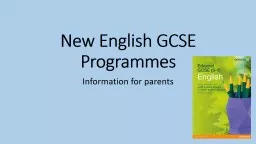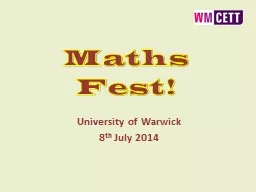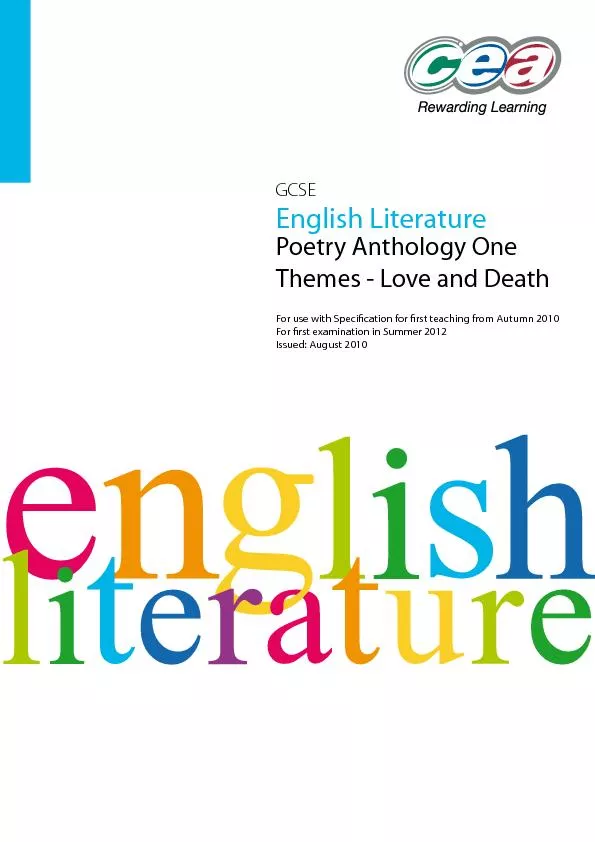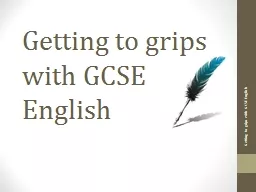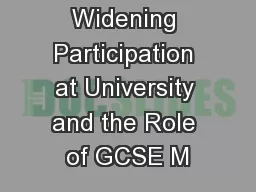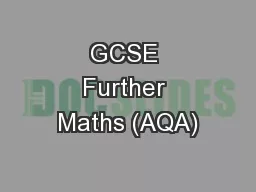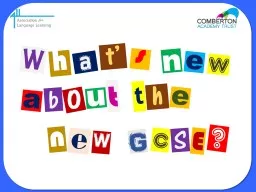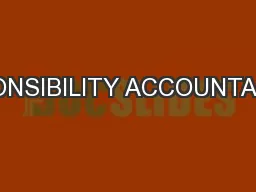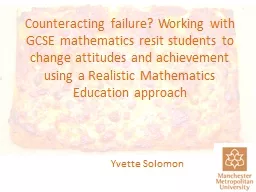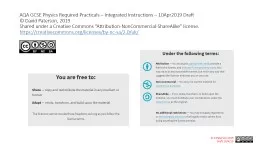PPT-New English GCSE Programmes
Author : tatiana-dople | Published Date : 2017-09-02
Information for parents A typical exam question would be How does Dickens use language and structure to build up a sense of tension in this extract OR Evaluate how
Presentation Embed Code
Download Presentation
Download Presentation The PPT/PDF document "New English GCSE Programmes" is the property of its rightful owner. Permission is granted to download and print the materials on this website for personal, non-commercial use only, and to display it on your personal computer provided you do not modify the materials and that you retain all copyright notices contained in the materials. By downloading content from our website, you accept the terms of this agreement.
New English GCSE Programmes: Transcript
Information for parents A typical exam question would be How does Dickens use language and structure to build up a sense of tension in this extract OR Evaluate how successfully Dickens uses language and structure to build up a sense of tension in this extract. Chatham Grammar School for Boys. New GCSE Grades. 2017 – English & Maths. 2018 – all subjects. A*. A . B. C. D. E. F. G. 9. 8. 7. 6. 5. 4. 3. 2. 1. Equating the Present and New Systems. Originally 1 – 8 scale. 8. th. July 2014. Maths . Fest!. Aims of the day. To build on the success of the GCSE Maths Enhancement Programme. To inform about the latest news & initiatives. To raise & discuss issues & ideas. CCEA GCSE English Literature - Poetry Anthologies CCEA GCSE English Literature - Poetry AnthologiesCONTENTS PAGELIST AOzymandiasPB ShelleyA Poison Tree William Blake e Five Students omas HardyLa Bel English. Getting to grips with GCSE English. Getting to grips with GCSE English. Most students will take 2 GCSEs. English Language . and. English Literature. Getting to grips with GCSE English. Changes. 2015-17. OCR A Schools History Project J415 (September 2013 onwards). 1: What is your child studying?. 2:What . skills are required for GCSE success?. 3: Home/School partnerships: Practical ideas for helping students to achieve their potential.. New rules, new challenges…. Statutory PoS at KS2 (and new PoS at KS3). More ‘rigorous’ GCSE (and A level) examinations. Return to compulsory languages at KS4 (by a different name!) . “The . need to promote effective transition in languages between Key Stages 2 and 3 is not . A case study of Bristol . Richard . Budd (Liverpool . Hope. . University). Anna Edwards (University of Bristol). Alf Coles (University of Bristol). Rosamund . Sutherland (University of Bristol). Ros.sutherland@bris.ac.uk. These slides can be used as a learning resource for students. . Some answers are broken down into steps for understanding and some are “final answers” that need you to provide your own method for.. Year 9 Options Evening. Science Faculty. Presentation Contents. Course Content of new GCSE Science. Science Options – Combined or Triple?. Module Grid and Class Structure. Exam . Structure. Practical Endorsement. Edexcel has submitted Draft 2 to . Ofqual. and published the revised SAMS with blue highlighting showing changes. AQA has submitted Draft 2 to . Ofqual. but will not publish again until they are approved (Draft 1 available on website). GCSE (9-1) Biology. GCSE (9-1) Chemistry. GCSE (9-1) Physics. or. GCSE (9-1) Combined Science (Double Award). There will no longer be a single GCSE Science qualification. What are the changes?. GCSE Science 2016: What’s changed?. Equipment. Homework. Uniform. Communication. Teach Prepare Support . MORAL VALUES . Try your best – all day, every day. Elton Times. Emails – please contact . eltonhigh@bury.sch.uk. . 1. Do I believe my child is almost perfect?. Yvette Solomon. The size of the problem. GCSE resit entry and achievement of Grade A*- C as a proportion of those who did not achieve by age 16. GCSE resit achievement rates. The issue 1. The issue 2. AQA GCSE Physics Required Practicals – Integrated Instructions – 10Apr2019 Draft © David Paterson, 2019 Shared under a Creative Commons “Attribution- NonCommercial - ShareAlike ” license. https://creativecommons.org/licenses/by-nc-sa/2.0/uk/
Download Document
Here is the link to download the presentation.
"New English GCSE Programmes"The content belongs to its owner. You may download and print it for personal use, without modification, and keep all copyright notices. By downloading, you agree to these terms.
Related Documents

